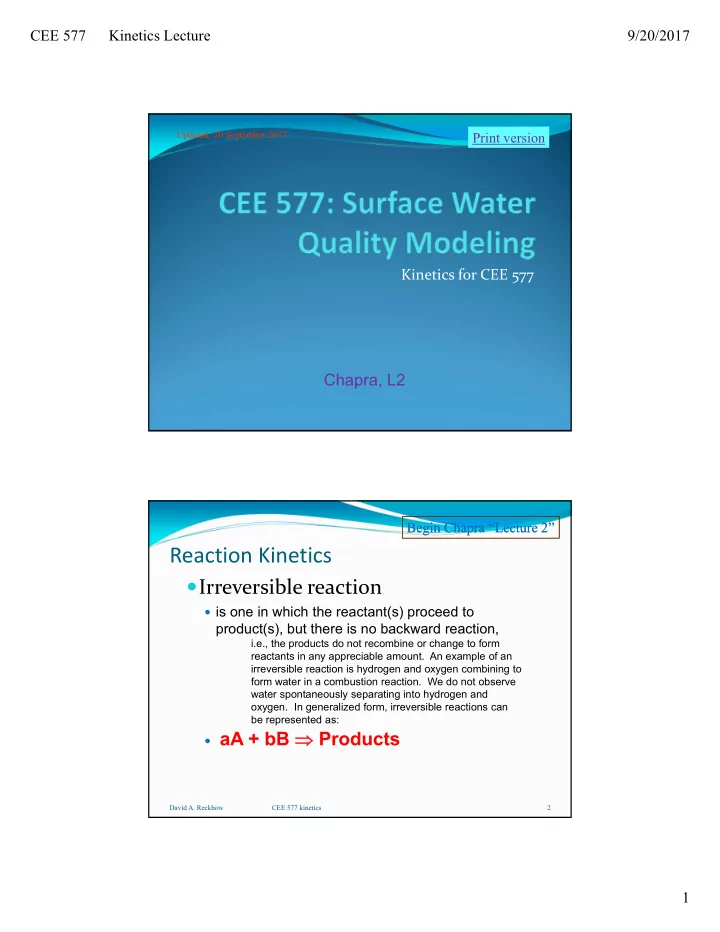

CEE 577 Kinetics Lecture 9/20/2017 Updated: 20 September 2017 Print version Kinetics for CEE 577 Chapra, L2 Begin Chapra “Lecture 2” Begin Chapra “Lecture 2” Reaction Kinetics Irreversible reaction is one in which the reactant(s) proceed to product(s), but there is no backward reaction, i.e., the products do not recombine or change to form reactants in any appreciable amount. An example of an irreversible reaction is hydrogen and oxygen combining to form water in a combustion reaction. We do not observe water spontaneously separating into hydrogen and oxygen. In generalized form, irreversible reactions can be represented as: aA + bB Products David A. Reckhow CEE 577 kinetics 2 1
CEE 577 Kinetics Lecture 9/20/2017 Reaction Kinetics: Reversibility A reversible reaction is one in which the reactant(s) proceed to product(s), but the product(s) react at an appreciable rate to reform reactant(s). aA + bB pP + qQ Many biological reactions fit into this category. An example of a reversible reaction is the formation of adenosine triphosphate (ATP) and adenosine diphosphate (ADP). All living organisms use ATP (or a similar compound) to store energy. As the ATP is used it is converted to ADP, the organism then uses food to reconvert the ADP to ATP. David A. Reckhow CEE 577 kinetics 3 Kinetic principles Law of Mass Action For elementary reactions k aA bB products rate a b kC A C where, B C A = concentration of reactant species A, [moles/liter] C B = concentration of reactant species B, [moles/liter] a = stoichiometric coefficient of species A b = stoichiometric coefficient of species B k = rate constant, [units are dependent on a and b] David A. Reckhow CEE 577 kinetics 4 2
CEE 577 Kinetics Lecture 9/20/2017 Reaction Kinetics (cont.) Reactions of order dc kc n “n” in reactant “c” dt When n=0, we have a 90 simple zero ‐ order 80 c c kt 70 reaction Concentration o 60 50 dc 40 k Slope 30 dt 20 10 / / min k mg l 10 0 0 20 40 60 80 Time (min) David A. Reckhow CEE 577 kinetics 5 Reaction Kinetics (cont.) dc 1 kc dt When n=1, we 90 have a simple 80 first ‐ order 70 kt Concentration c c e reaction 60 o This results in an 50 40 “exponential 30 decay” 20 Half ‐ life? k 1 0 032 . min 10 0 0 20 40 60 80 Time (min) David A. Reckhow CEE 577 kinetics 6 3
CEE 577 Kinetics Lecture 9/20/2017 Reaction Kinetics (cont.) dc 1 kc dt This equation 100 can be Concentration (log scale) linearized ln ln c c kt good for o assessment of Slope “k” from data k 1 0 032 . min 10 0 20 40 60 80 Time (min) David A. Reckhow CEE 577 kinetics 7 dc 2 Reaction Kinetics (cont.) kc dt When n=2, we have a simple second-order reaction 90 1 80 This results in 70 c c Concentration an especially 60 1 o kc t wide range in 50 o 40 rates 0 0015 . / / min k L mg 30 20 10 0 0 20 40 60 80 Time (min) David A. Reckhow CEE 577 kinetics 8 4
CEE 577 Kinetics Lecture 9/20/2017 Reaction Kinetics (cont.) dc 2 kc Again, the equation can be linearized dt to estimate “k” from data Time (min) 0 20 40 60 80 0.12 1 1 kt 0.1 1/Concentration c c 0.08 o 0.06 Slope 0.04 0 0015 . / / min k L mg 0.02 0 David A. Reckhow CEE 577 kinetics 9 Comparison of Reaction Orders Curvature: 2nd>1st>zero 90 80 Zero Order 70 Concentration First Order 60 50 Second Order 40 30 20 10 0 0 20 40 60 80 Time (min) David A. Reckhow CEE 577 kinetics 10 5
CEE 577 Kinetics Lecture 9/20/2017 Variable Kinetic Order Any reaction order, except n=1 dc n kc 1 1 dt kt 1 n 1 1 n n c c o 1 c c 1 o 1 1 1 1 n n n kc t o David A. Reckhow CEE 577 kinetics 11 Reversible reaction kinetics k For a general reversible reaction: f aA + bB pP + qQ k b And the rate law must consider both forward and reverse reactions: a b p q = k C C - k C C r A f b A B P Q where, k f = forward rate constant, [units depend on a and b] k b = backward rate constant, [units depend on a and b] C P = concentration of product species P, [moles/liter] C Q = concentration of product species Q, [moles/liter] p = stoichiometric coefficient of species P q = stoichiometric coefficient of species Q David A. Reckhow CEE 577 kinetics 12 6
CEE 577 Kinetics Lecture 9/20/2017 Analysis of Rate Data Integral Method Least squares regression of linearized form Differential Method estimate instantaneous rate at known time and reactant concentration Initial rate Method more rigorous, but slow Method of Excess only when 2 or more reactants are involved David A. Reckhow CEE 577 kinetics 13 Stoichiometry and Temp Stoichiometry refer to Chapra or any chemistry book Temperature E RTa k Ae Arrhenius Equation Ta k T T T 1 1 2 Engineering Approach: k T 2 David A. Reckhow CEE 577 kinetics 14 7
CEE 577 Kinetics Lecture 9/20/2017 End David A. Reckhow CEE 577 kinetics 15 8
Recommend
More recommend